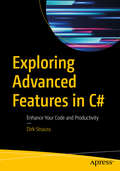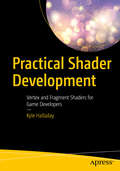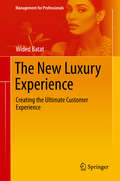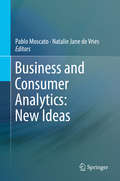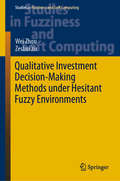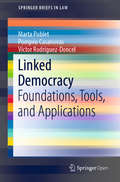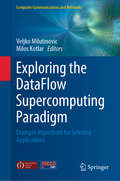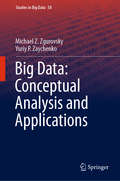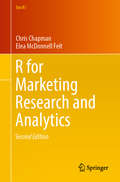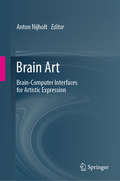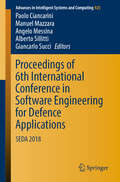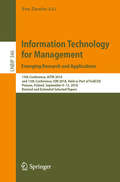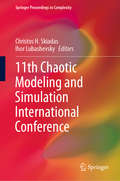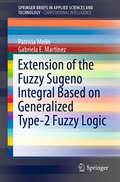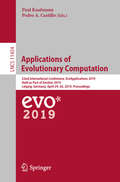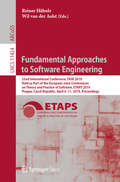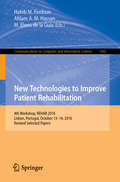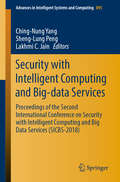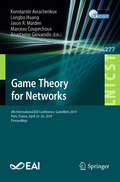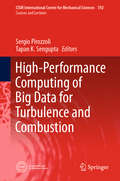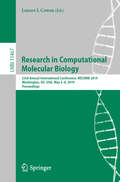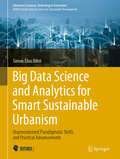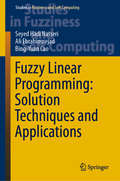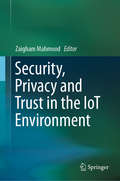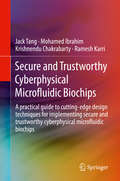- Table View
- List View
Exploring Advanced Features in C#: Enhance Your Code and Productivity
by Dirk StraussBecome a more productive programmer by leveraging the newest features available to you in C#. This book highlights the new language features available to you and how to use these and other tools such as Bootstrap, SCSS, and jQuery to enhance your web applications.Exploring Advanced Features in C# starts with some of the new features of C# 7 such as how to implement local functions, tuples and generalized async return types. The book also looks at C# 8, where the author demonstrates how to implement nullable reference types, recursive patterns, ranges, indicies, switch expressions, and many more. Next, you go through some of the distinct features of C# that might often be overlooked such as generics, asynchronous programming, and dynamic types. The author demonstrates how to implement these features through clear and concise examples. Next, you’ll discuss creating responsive web applications using ASP.NET Model View Controller (MVC) where you’ll learn how to combine Bootstrap with jQuery and SCSS to create interactive web applications with a great-looking, user-friendly UI. Moving forward, you will create and run applications on the latest .NET Core version 3.0 as well as explore some of the features of .NET Core 3.0. Finally, you will go through the tips and tricks of Visual Studio 2019 that make you more productive.After reading the book, you will be able to implement new features available in C# and learn how to enhance your application development using ASP.NET MVC and .NET Core.What You Will LearnImplement the new features available in C# 7Enhance your web applications using ASP.NET MVC, Bootstrap, SCSS, and jQuery See what C# 8 has to offer with clear code examples Create and run applications in .NET Core 3.0Who This Is Book ForC# programmers who have worked with C# for a number of years and who want to keep up to date with the latest advancements of the language .
Practical Shader Development: Vertex and Fragment Shaders for Game Developers
by Kyle HalladayIt’s time to stop thinking that shaders are magical. You can use shaders to turn data into stunning visual effects, and get your hands dirty by building your own shader with this step-by-step introduction to shader development for game and graphics developers. Learn how to make shaders that move, tint, light up, and look awesome, all without cracking open a math textbook.Practical Shader Development teaches the theory behind how shaders work. The book also shows you how to apply that theory to create eye-popping visual effects. You’ll learn to profile and optimize those effects to make sure your projects keep running quickly with all their new visuals. You’ll learn good theory, good practices, and without getting bogged down in the math. Author Kyle Halladay explains the fundamentals of shader development through simple examples and hands-on experiments. He teaches you how to find performance issues in shaders you are using and then how to fix them. Kyle explains (and contrasts) how to use the knowledge learned from this book in three of the most popular game engines today. What You'll LearnUnderstand what shaders are and how they workGet up to speed on the nuts and bolts of writing vertex and fragment shadersUtilize color blending and know how blend equations workKnow the coordinate spaces used when rendering real-time computer graphicsUse simple math to animate characters, simulate lights, and create a wide variety of visual effectsFind and fix performance problems in shadersSee how three popular game engines (Unity, UE4, Godot) handle shadersWho This Book Is ForProgrammers who are interested in writing their own shaders but do not know where to start, anyone who has ever seen shader code on a forum and wished they knew how to modify it just a little bit to fit into their own projects, and game developers who are tired of using the default shaders found in the game engines they are using. The book is especially useful for those who have been put off by existing shader tutorials which introduce complex math and graphics theory before ever getting something on the screen.
The New Luxury Experience: Creating the Ultimate Customer Experience (Management for Professionals)
by Wided BatatThis professional book introduces marketing and luxury brand professionals to a new definition of luxury and the art of designing the ultimate luxury experience in both the physical space (e.g., in-store, hotel, restaurant) and the digital space (e.g., social media, website, e-commerce). Specifically, it offers an overview of customer experience issues and explores big five experiential strategies that can be applied by luxury houses in order to provide the best luxury experience to their customers. Themes such as quality of customer luxury experience, immersion and co-production/co-creation in luxury, creation and management, digital and immersive marketing, and innovative market research are also examined. How do consumers define luxury? Is there one luxury or several “luxuries”? What kind of luxury experiences consumers want to live? How can luxury houses design the ultimate luxury experience? More than in any other sector, luxury consumption is a response to a search for emotions, pleasure, uniqueness, consideration and greatest services. The luxury consumer wants to live luxury experiences – not just buy luxury products or services. In this way, this book presents the luxury consumption experience as a combination of symbolic meaning, subconscious processes and nonverbal cues and characterized by fantasies, feelings and fun. Featuring case studies and interviews from international luxury sectors and brand managers such as Burberry, Dior, Porsche, Breitling, St. Regis Hotels & Resorts, and Louis Vuitton, among others, this book offers both a research and management perspective on luxury experience to professionals in the luxury sector (e.g., CEOs, brand managers, marketing and communication professionals), as well as marketing professors, students, and people eager to learn more about how to design the ultimate luxury experience. Praise for The New Luxury Experience “This book provides a holistic perspective on marketing of luxury brands, offering both useful practical advice as well as illustrating important cases.” -- Ravi Dhar, Director, Yale Center for Customer Insights, Yale University “Wided Batat’s book offers a fresh, insightful and comprehensive analysis of the concept of the consumer’s experience with luxury whatever that may be. The Five experiential luxury strategies proposed by Wided highlight that luxury management should go above and beyond the design and branding of luxury goods and services. I also commend the consideration given to the younger generations’ approach to luxury and to corporate social responsibility aspects. Luxury marketers should find this book very useful indeed.” -- Francesca Dall’Olmo Riley, Professor of Brand Management, Kingston Business School, UK
Business and Consumer Analytics: New Ideas
by Pablo Moscato Natalie Jane de VriesThis two-volume handbook presents a collection of novel methodologies with applications and illustrative examples in the areas of data-driven computational social sciences. Throughout this handbook, the focus is kept specifically on business and consumer-oriented applications with interesting sections ranging from clustering and network analysis, meta-analytics, memetic algorithms, machine learning, recommender systems methodologies, parallel pattern mining and data mining to specific applications in market segmentation, travel, fashion or entertainment analytics. A must-read for anyone in data-analytics, marketing, behavior modelling and computational social science, interested in the latest applications of new computer science methodologies.The chapters are contributed by leading experts in the associated fields.The chapters cover technical aspects at different levels, some of which are introductory and could be used for teaching. Some chapters aim at building a common understanding of the methodologies and recent application areas including the introduction of new theoretical results in the complexity of core problems. Business and marketing professionals may use the book to familiarize themselves with some important foundations of data science. The work is a good starting point to establish an open dialogue of communication between professionals and researchers from different fields.Together, the two volumes present a number of different new directions in Business and Customer Analytics with an emphasis in personalization of services, the development of new mathematical models and new algorithms, heuristics and metaheuristics applied to the challenging problems in the field. Sections of the book have introductory material to more specific and advanced themes in some of the chapters, allowing the volumes to be used as an advanced textbook. Clustering, Proximity Graphs, Pattern Mining, Frequent Itemset Mining, Feature Engineering, Network and Community Detection, Network-based Recommending Systems and Visualization, are some of the topics in the first volume. Techniques on Memetic Algorithms and their applications to Business Analytics and Data Science are surveyed in the second volume; applications in Team Orienteering, Competitive Facility-location, and Visualization of Products and Consumers are also discussed. The second volume also includes an introduction to Meta-Analytics, and to the application areas of Fashion and Travel Analytics. Overall, the two-volume set helps to describe some fundamentals, acts as a bridge between different disciplines, and presents important results in a rapidly moving field combining powerful optimization techniques allied to new mathematical models critical for personalization of services. Academics and professionals working in the area of business anyalytics, data science, operations research and marketing will find this handbook valuable as a reference. Students studying these fields will find this handbook useful and helpful as a secondary textbook.
Qualitative Investment Decision-Making Methods under Hesitant Fuzzy Environments (Studies in Fuzziness and Soft Computing #376)
by Wei Zhou Zeshui XuThis book describes five qualitative investment decision-making methods based on the hesitant fuzzy information. They are: (1) the investment decision-making method based on the asymmetric hesitant fuzzy sigmoid preference relations, (2) the investment decision-making method based on the hesitant fuzzy trade-off and portfolio selection, (3) the investment decision-making method based on the hesitant fuzzy preference envelopment analysis, (4) the investment decision-making method based on the hesitant fuzzy peer-evaluation and strategy fusion, and (5) the investment decision-making method based on the EHVaR measurement and tail analysis.
Linked Democracy: Foundations, Tools, and Applications (SpringerBriefs in Law)
by Marta Poblet Pompeu Casanovas Víctor Rodríguez-DoncelThis open access book shows the factors linking information flow, social intelligence, rights management and modelling with epistemic democracy, offering licensed linked data along with information about the rights involved. This model of democracy for the web of data brings new challenges for the social organisation of knowledge, collective innovation, and the coordination of actions. Licensed linked data, licensed linguistic linked data, right expression languages, semantic web regulatory models, electronic institutions, artificial socio-cognitive systems are examples of regulatory and institutional design (regulations by design). The web has been massively populated with both data and services, and semantically structured data, the linked data cloud, facilitates and fosters human-machine interaction. Linked data aims to create ecosystems to make it possible to browse, discover, exploit and reuse data sets for applications. Rights Expression Languages semi-automatically regulate the use and reuse of content.
Exploring the DataFlow Supercomputing Paradigm: Example Algorithms for Selected Applications (Computer Communications and Networks)
by Veljko Milutinovic Milos KotlarThis useful text/reference describes the implementation of a varied selection of algorithms in the DataFlow paradigm, highlighting the exciting potential of DataFlow computing for applications in such areas as image understanding, biomedicine, physics simulation, and business.The mapping of additional algorithms onto the DataFlow architecture is also covered in the following Springer titles from the same team: DataFlow Supercomputing Essentials: Research, Development and Education, DataFlow Supercomputing Essentials: Algorithms, Applications and Implementations, and Guide to DataFlow Supercomputing.Topics and Features: introduces a novel method of graph partitioning for large graphs involving the construction of a skeleton graph; describes a cloud-supported web-based integrated development environment that can develop and run programs without DataFlow hardware owned by the user; showcases a new approach for the calculation of the extrema of functions in one dimension, by implementing the Golden Section Search algorithm; reviews algorithms for a DataFlow architecture that uses matrices and vectors as the underlying data structure; presents an algorithm for spherical code design, based on the variable repulsion force method; discusses the implementation of a face recognition application, using the DataFlow paradigm; proposes a method for region of interest-based image segmentation of mammogram images on high-performance reconfigurable DataFlow computers; surveys a diverse range of DataFlow applications in physics simulations, and investigates a DataFlow implementation of a Bitcoin mining algorithm.This unique volume will prove a valuable reference for researchers and programmers of DataFlow computing, and supercomputing in general. Graduate and advanced undergraduate students will also find that the book serves as an ideal supplementary text for courses on Data Mining, Microprocessor Systems, and VLSI Systems.
Big Data: Conceptual Analysis and Applications (Studies in Big Data #58)
by Michael Z. Zgurovsky Yuriy P. ZaychenkoThe book is devoted to the analysis of big data in order to extract from these data hidden patterns necessary for making decisions about the rational behavior of complex systems with the different nature that generate this data. To solve these problems, a group of new methods and tools is used, based on the self-organization of computational processes, the use of crisp and fuzzy cluster analysis methods, hybrid neural-fuzzy networks, and others. The book solves various practical problems. In particular, for the tasks of 3D image recognition and automatic speech recognition large-scale neural networks with applications for Deep Learning systems were used. Application of hybrid neuro-fuzzy networks for analyzing stock markets was presented. The analysis of big historical, economic and physical data revealed the hidden Fibonacci pattern about the course of systemic world conflicts and their connection with the Kondratieff big economic cycles and the Schwabe–Wolf solar activity cycles. The book is useful for system analysts and practitioners working with complex systems in various spheres of human activity.
R For Marketing Research and Analytics (Use R!)
by Chris Chapman Elea McDonnell FeitThe 2nd edition of R for Marketing Research and Analytics continues to be the best place to learn R for marketing research. This book is a complete introduction to the power of R for marketing research practitioners. The text describes statistical models from a conceptual point of view with a minimal amount of mathematics, presuming only an introductory knowledge of statistics. Hands-on chapters accelerate the learning curve by asking readers to interact with R from the beginning. Core topics include the R language, basic statistics, linear modeling, and data visualization, which is presented throughout as an integral part of analysis.Later chapters cover more advanced topics yet are intended to be approachable for all analysts. These sections examine logistic regression, customer segmentation, hierarchical linear modeling, market basket analysis, structural equation modeling, and conjoint analysis in R. The text uniquely presents Bayesian models with a minimally complex approach, demonstrating and explaining Bayesian methods alongside traditional analyses for analysis of variance, linear models, and metric and choice-based conjoint analysis. With its emphasis on data visualization, model assessment, and development of statistical intuition, this book provides guidance for any analyst looking to develop or improve skills in R for marketing applications.The 2nd edition increases the book’s utility for students and instructors with the inclusion of exercises and classroom slides. At the same time, it retains all of the features that make it a vital resource for practitioners: non-mathematical exposition, examples modeled on real world marketing problems, intuitive guidance on research methods, and immediately applicable code.
Brain Art: Brain-Computer Interfaces for Artistic Expression
by Anton NijholtThis is the first book on brain-computer interfaces (BCI) that aims to explain how these BCI interfaces can be used for artistic goals. Devices that measure changes in brain activity in various regions of our brain are available and they make it possible to investigate how brain activity is related to experiencing and creating art. Brain activity can also be monitored in order to find out about the affective state of a performer or bystander and use this knowledge to create or adapt an interactive multi-sensorial (audio, visual, tactile) piece of art. Making use of the measured affective state is just one of the possible ways to use BCI for artistic expression. We can also stimulate brain activity. It can be evoked externally by exposing our brain to external events, whether they are visual, auditory, or tactile. Knowing about the stimuli and the effect on the brain makes it possible to translate such external stimuli to decisions and commands that help to design, implement, or adapt an artistic performance, or interactive installation. Stimulating brain activity can also be done internally. Brain activity can be voluntarily manipulated and changes can be translated into computer commands to realize an artistic vision. The chapters in this book have been written by researchers in human-computer interaction, brain-computer interaction, neuroscience, psychology and social sciences, often in cooperation with artists using BCI in their work. It is the perfect book for those seeking to learn about brain-computer interfaces used for artistic applications.
Proceedings of 6th International Conference in Software Engineering for Defence Applications: SEDA 2018 (Advances in Intelligent Systems and Computing #925)
by Paolo Ciancarini Manuel Mazzara Angelo Messina Alberto Sillitti Giancarlo SucciThis book presents high-quality original contributions on new software engineering models, approaches, methods, and tools and their evaluation in the context of defence and security applications. In addition, important business and economic aspects are discussed, with a particular focus on cost/benefit analysis, new business models, organizational evolution, and business intelligence systems. The contents are based on presentations delivered at SEDA 2018, the 6th International Conference in Software Engineering for Defence Applications, which was held in Rome, Italy, in June 2018. This conference series represents a targeted response to the growing need for research that reports and debates the practical implications of software engineering within the defence environment and also for software performance evaluation in real settings through controlled experiments as well as case and field studies. The book will appeal to all with an interest in modeling, managing, and implementing defence-related software development products and processes in a structured and supportable way.
Information Technology for Management: 15th Conference, AITM 2018, and 13th Conference, ISM 2018, Held as Part of FedCSIS, Poznan, Poland, September 9–12, 2018, Revised and Extended Selected Papers (Lecture Notes in Business Information Processing #346)
by Ewa ZiembaThis book constitutes extended selected papers from the 16th Conference on Advanced Information Technologies for Management, AITM 2018, and the 13th Conference on Information Systems Management, ISM 2018, held as part of the Federated Conference on Computer Science and Information Systems, FedCSIS, which took place in Poznan, Poland, in September 2018. The total of 9 full and 3 short papers presented in this volume were carefully reviewed and selected from a total of 43 submissions. The papers selected to be included in this book contribute to the understanding of relevant trends of current research on information technology for management in business and public organizations. They were organized in topical sections named: information technology and systems for knowledge management, and information technology and systems for business transformation.
11th Chaotic Modeling and Simulation International Conference (Springer Proceedings in Complexity)
by Christos H. Skiadas Ihor LubashevskyGathering the proceedings of the 11th CHAOS2018 International Conference, this book highlights recent developments in nonlinear, dynamical and complex systems. The conference was intended to provide an essential forum for Scientists and Engineers to exchange ideas, methods, and techniques in the field of Nonlinear Dynamics, Chaos, Fractals and their applications in General Science and the Engineering Sciences. The respective chapters address key methods, empirical data and computer techniques, as well as major theoretical advances in the applied nonlinear field. Beyond showcasing the state of the art, the book will help academic and industrial researchers alike apply chaotic theory in their studies.
Extension of the Fuzzy Sugeno Integral Based on Generalized Type-2 Fuzzy Logic (SpringerBriefs in Applied Sciences and Technology)
by Patricia Melin Gabriela E. MartinezThis book presents an extension of the aggregation operator of the generalized interval type-2 Sugeno integral using generalized type-2 fuzzy logic. This extension enables it to handle higher levels of uncertainty when adding any number of sources and types of information in a wide variety of decision-making applications. The authors also demonstrate that the extended aggregation operator offers better performance than other traditional or extended operators. The book is a valuables reference resource for students and researchers working on theory and applications of fuzzy logic in various areas of application where decision making is performed under high levels of uncertainty, such as pattern recognition, time series prediction, intelligent control and manufacturing.
Applications of Evolutionary Computation: 22nd International Conference, EvoApplications 2019, Held as Part of EvoStar 2019, Leipzig, Germany, April 24–26, 2019, Proceedings (Lecture Notes in Computer Science #11454)
by Paul Kaufmann Pedro A. CastilloThis book constitutes the refereed proceedings of the 22nd International Conference on Applications of Evolutionary Computation, EvoApplications 2019, held in Leipzig, Germany, in April 2019, co-located with the Evo*2019 events EuroGP, EvoCOP and EvoMUSART. The 44 revised full papers presented were carefully reviewed and selected from 66 submissions. They were organized in topical sections named: Engineering and Real World Applications; Games; General; Image and Signal Processing; Life Sciences; Networks and Distributed Systems; Neuroevolution and Data Analytics; Numerical Optimization: Theory, Benchmarks, and Applications; Robotics.
Fundamental Approaches to Software Engineering: 22nd International Conference, FASE 2019, Held as Part of the European Joint Conferences on Theory and Practice of Software, ETAPS 2019, Prague, Czech Republic, April 6–11, 2019, Proceedings (Lecture Notes in Computer Science #11424)
by Reiner Hähnle Wil van der AalstThis book is Open Access under a CC BY licence.This book constitutes the proceedings of the 22nd International Conference on Fundamental Approaches to Software Engineering, FASE 2019, which took place in Prague, Czech Republic in April 2019, held as Part of the European Joint Conferences on Theory and Practice of Software, ETAPS 2019.The 24 papers presented in this volume were carefully reviewed and selected from 94 submissions. The papers are organized in topical sections named: software verification; model-driven development and model transformation; software evolution and requirements engineering; specification, design, and implementation of particular classes of systems; and software testing.
New Technologies to Improve Patient Rehabilitation: 4th Workshop, REHAB 2016, Lisbon, Portugal, October 13-14, 2016, Revised Selected Papers (Communications in Computer and Information Science #1002)
by Habib M. Fardoun Ahlam A. Hassan M. Elena de la GuíaThis book constitutes the thoroughly refereed proceedings of the 4th International Workshop on ICTs for Improving Patients Rehabilitation Research Techniques, REHAB 2016, held in Lisbon, Portugal, in October 2016.The 10 revised full papers presented were carefully reviewed and selected from 33 submissions. The papers explore how technology can contribute toward smarter and effective rehabilitation methods.
Security with Intelligent Computing and Big-data Services: Proceedings of the Second International Conference on Security with Intelligent Computing and Big Data Services (SICBS-2018) (Advances in Intelligent Systems and Computing #895)
by Ching-Nung Yang Sheng-Lung Peng Lakhmi C. JainThis book presents the proceedings of the 2018 International Conference on Security with Intelligent Computing and Big-data Services (SICBS 2018). With the proliferation of security with intelligent computing and big-data services, the issues of information security, big data, intelligent computing, blockchain technology, and network security have attracted a growing number of researchers. Discussing topics in areas including blockchain technology and applications; multimedia security; information processing; network, cloud and IoT security; cryptography and cryptosystems; as well as learning and intelligent computing and information hiding, the book provides a platform for researchers, engineers, academics and industrial professionals from around the globe to present their work in security-related areas. It not only introduces novel and interesting ideas, but also stimulates discussions and inspires new ideas.
Game Theory for Networks: 8th International EAI Conference, GameNets 2019, Paris, France, April 25–26, 2019, Proceedings (Lecture Notes of the Institute for Computer Sciences, Social Informatics and Telecommunications Engineering #277)
by Konstantin Avrachenkov Longbo Huang Jason R. Marden Marceau Coupechoux Anastasios GiovanidisThis book constitutes the refereed proceedings of the 8th EAI International Conference on Game Theory for Networks, GameNets 2019, held in Paris, France, in April 2019. The 8 full and 3 short papers presented were carefully reviewed and selected from 17 submissions. They are organized in the following topical sections: Game Theory for Wireless Networks; Games for Economy and Resource Allocation; and Game Theory for Social Networks.
High-Performance Computing of Big Data for Turbulence and Combustion (CISM International Centre for Mechanical Sciences #592)
by Sergio Pirozzoli Tapan K. SenguptaThis book provides state-of-art information on high-accuracy scientific computing and its future prospects, as applicable to the broad areas of fluid mechanics and combustion, and across all speed regimes. Beginning with the concepts of space-time discretization and dispersion relation in numerical computing, the foundations are laid for the efficient solution of the Navier-Stokes equations, with special reference to prominent approaches such as LES, DES and DNS. The basis of high-accuracy computing is rooted in the concept of stability, dispersion and phase errors, which require the comprehensive analysis of discrete computing by rigorously applying error dynamics. In this context, high-order finite-difference and finite-volume methods are presented. Naturally, the coverage also includes fundamental notions of high-performance computing and advanced concepts on parallel computing, including their implementation in prospective hexascale computers. Moreover, the book seeks to raise the bar beyond the pedagogical use of high-accuracy computing by addressing more complex physical scenarios, including turbulent combustion. Tools like proper orthogonal decomposition (POD), proper generalized decomposition (PGD), singular value decomposition (SVD), recursive POD, and high-order SVD in multi-parameter spaces are presented. Special attention is paid to bivariate and multivariate datasets in connection with various canonical flow and heat transfer cases. The book mainly addresses the needs of researchers and doctoral students in mechanical engineering, aerospace engineering, and all applied disciplines including applied mathematics, offering these readers a unique resource.
Research in Computational Molecular Biology: 23rd Annual International Conference, RECOMB 2019, Washington, DC, USA, May 5-8, 2019, Proceedings (Lecture Notes in Computer Science #11467)
by Lenore J. CowenThis book constitutes the proceedings of the 23rd Annual Conference on Research in Computational Molecular Biology, RECOMB 2019, held in Washington, DC, USA, in April 2019. The 17 extended and 20 short abstracts presented were carefully reviewed and selected from 175 submissions. The short abstracts are included in the back matter of the volume. The papers report on original research in all areas of computational molecular biology and bioinformatics.
Big Data Science and Analytics for Smart Sustainable Urbanism: Unprecedented Paradigmatic Shifts and Practical Advancements (Advances in Science, Technology & Innovation)
by Simon Elias BibriWe are living at the dawn of what has been termed ‘the fourth paradigm of science,’ a scientific revolution that is marked by both the emergence of big data science and analytics, and by the increasing adoption of the underlying technologies in scientific and scholarly research practices. Everything about science development or knowledge production is fundamentally changing thanks to the ever-increasing deluge of data. This is the primary fuel of the new age, which powerful computational processes or analytics algorithms are using to generate valuable knowledge for enhanced decision-making, and deep insights pertaining to a wide variety of practical uses and applications. This book addresses the complex interplay of the scientific, technological, and social dimensions of the city, and what it entails in terms of the systemic implications for smart sustainable urbanism. In concrete terms, it explores the interdisciplinary and transdisciplinary field of smart sustainable urbanism and the unprecedented paradigmatic shifts and practical advances it is undergoing in light of big data science and analytics. This new era of science and technology embodies an unprecedentedly transformative and constitutive power—manifested not only in the form of revolutionizing science and transforming knowledge, but also in advancing social practices, producing new discourses, catalyzing major shifts, and fostering societal transitions. Of particular relevance, it is instigating a massive change in the way both smart cities and sustainable cities are studied and understood, and in how they are planned, designed, operated, managed, and governed in the face of urbanization. This relates to what has been dubbed data-driven smart sustainable urbanism, an emerging approach based on a computational understanding of city systems and processes that reduces urban life to logical and algorithmic rules and procedures, while also harnessing urban big data to provide a more holistic and integrated view or synoptic intelligence of the city. This is increasingly being directed towards improving, advancing, and maintaining the contribution of both sustainable cities and smart cities to the goals of sustainable development. This timely and multifaceted book is aimed at a broad readership. As such, it will appeal to urban scientists, data scientists, urbanists, planners, engineers, designers, policymakers, philosophers of science, and futurists, as well as all readers interested in an overview of the pivotal role of big data science and analytics in advancing every academic discipline and social practice concerned with data–intensive science and its application, particularly in relation to sustainability.
Fuzzy Linear Programming: Solution Techniques and Applications (Studies in Fuzziness and Soft Computing #379)
by Seyed Hadi Nasseri Ali Ebrahimnejad Bing-Yuan CaoThis book presents the necessary and essential backgrounds of fuzzy set theory and linear programming, particularly a broad range of common Fuzzy Linear Programming (FLP) models and related, convenient solution techniques. These models and methods belong to three common classes of fuzzy linear programming, namely: (i) FLP problems in which all coefficients are fuzzy numbers, (ii) FLP problems in which the right-hand-side vectors and the decision variables are fuzzy numbers, and (iii) FLP problems in which the cost coefficients, the right-hand-side vectors and the decision variables are fuzzy numbers. The book essentially generalizes the well-known solution algorithms used in linear programming to the fuzzy environment. Accordingly, it can be used not only as a textbook, teaching material or reference book for undergraduate and graduate students in courses on applied mathematics, computer science, management science, industrial engineering, artificial intelligence, fuzzy information processes, and operations research, but can also serve as a reference book for researchers in these fields, especially those engaged in optimization and soft computing. For textbook purposes, it also includes simple and illustrative examples to help readers who are new to the field.
Security, Privacy and Trust in the IoT Environment
by Zaigham MahmoodThe Internet of Things (IoT) is a network of devices and smart things that provides a pervasive environment in which people can interact with both the cyber and physical worlds. As the number and variety of connected objects continue to grow and the devices themselves become smarter, users’ expectations in terms of adaptive and self-governing digital environments are also on the rise. Although, this connectivity and the resultant smarter living is highly attractive to general public and profitable for the industry, there are also inherent concerns. The most challenging of these refer to the privacy and security of data, user trust of the digital systems, and relevant authentication mechanisms. These aspects call for novel network architectures and middleware platforms based on new communication technologies; as well as the adoption of novel context-aware management approaches and more efficient tools and devices.In this context, this book explores central issues of privacy, security and trust with regard to the IoT environments, as well as technical solutions to help address them. The main topics covered include:• Basic concepts, principles and related technologies• Security/privacy of data, and trust issues• Mechanisms for security, privacy, trust and authentication• Success indicators, performance metrics and future directions.This reference text is aimed at supporting a number of potential audiences, including• Network Specialists, Hardware Engineers and Security Experts • Students, Researchers, Academics and Practitioners.
Secure and Trustworthy Cyberphysical Microfluidic Biochips: A practical guide to cutting-edge design techniques for implementing secure and trustworthy cyberphysical microfluidic biochips
by Jack Tang Mohamed Ibrahim Krishnendu Chakrabarty Ramesh KarriThis book describes novel hardware security and microfluidic biochip design methodologies to protect against tampering attacks in cyberphysical microfluidic biochips (CPMBs). It also provides a general overview of this nascent area of research, which will prove to be a vital resource for practitioners in the field.This book shows how hardware-based countermeasures and design innovations can be a simple and effective last line of defense, demonstrating that it is no longer justifiable to ignore security and trust in the design phase of biochips.
